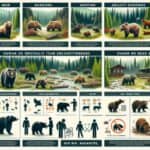Mastering the Art of Foraging: A Comprehensive Guide to Edible Plants
Finding Food in the Wild: Foraging for wild Food can dramatically shift a survival scenario from mere endurance to a fulfilling experience, making it vital to become adept at finding Food in the wild. Grasping the knowledge of edible plants forms the foundation of this essential skill, providing not only nourishment but also a profound connection to the natural world. By honing your ability to identify safe plants, you set the stage for a secure and enriching foraging journey that leaves you feeling empowered and in tune with nature.
Essential Techniques for Identifying Safe Edible Plants

Recognising safe edible plants is of utmost importance for anyone keen on finding Food in the wild. Familiarising yourself with local flora is critical for ensuring both safety and a rich foraging experience. Begin your journey by studying common edible plants in your area, such as dandelions, wild garlic, and clover. These plants often flourish in a variety of settings, from urban parks to rustic countryside.
A highly effective strategy is to use field guides or mobile applications specifically designed for plant identification. By cross-referencing images and detailed descriptions, you can confidently differentiate between edible and non-edible varieties. Joining local foraging groups or participating in workshops can further enhance your skills and provide valuable hands-on experience while allowing you to connect with others who share your passion. Engaging with the community not only enriches your knowledge but also sharpens your foraging abilities.
It’s essential to remember that even among edible species, a plant's maturity can significantly impact its safety and taste. Typically, younger leaves and shoots are more palatable, whereas older or tougher parts may be fibrous and less enjoyable. Don't hesitate to experiment with various parts of plants, including roots, flowers, and seeds, to diversify your diet and broaden your culinary repertoire, thereby enhancing your overall foraging experience.
Critical Insights for Avoiding Poisonous Plant Varieties
In the pursuit of finding Food in the wild, understanding the characteristics of poisonous plants is crucial for your safety. Numerous plants have toxic look-alikes that could lead to severe health consequences if misidentified. Therefore, it is essential to familiarise yourself with the most prevalent poisonous plants in your region, such as poison ivy, hemlock, and nightshade. Recognising their distinct features—such as leaf shape, flower colour, and growth patterns—can help prevent tragic mistakes.
Always adhere to the wise saying, “When in doubt, go without.” If there is any uncertainty regarding a plant’s edibility, it is best to refrain from consuming it. Poisonous plants can trigger severe reactions, ranging from mild discomfort to life-threatening conditions. By researching local flora and studying poisonous varieties alongside edible ones, you can enhance your understanding and boost your confidence in the wild.
Additionally, be mindful of potential cross-contamination while foraging. Thoroughly wash your hands and tools, and avoid mixing edible plants with known toxins. By taking these precautions, you can significantly reduce the risk of accidental poisoning and fully enjoy the rewards of finding Food in the wild.
Exploring the Nutritional Benefits of Wild Plants
Wild plants serve as a vital food source, offering impressive nutritional benefits that can support your health in survival situations. Many foraged plants are abundant in vitamins, minerals, and antioxidants, often surpassing the nutritional value of cultivated varieties. For instance, stinging nettles, rich in iron and vitamins A and C, can be a powerhouse addition to your diet.
Incorporating a diverse range of wild plants can help you maintain a balanced diet. Leafy greens provide essential fibre and vitamins, while berries offer antioxidants and natural sugars for energy. Understanding the nutritional profiles of various plants can significantly guide your foraging efforts and optimise your health during your adventures in nature.
Moreover, wild plants typically thrive in nutrient-rich soils, rendering them a more sustainable choice. By foraging responsibly, you contribute to ecological balance while nourishing your body. This dual benefit presents a compelling reason to embrace the practice of finding Food in the wild and to explore the wealth of nutrients available in your local ecosystem.
Understanding the Seasonal Availability of Edible Plants

One of the most captivating aspects of foraging is the seasonal availability of edible plants. Different plants flourish at various times throughout the year, making it essential to adjust your foraging techniques based on the season. In spring, tender greens like ramps and fiddleheads emerge, while summer heralds an abundance of berries and blossoming flowers.
As autumn arrives, look for nuts and seeds, which are rich in healthy fats and proteins. Understanding the seasonal growth cycles of plants can optimise your foraging efforts, ensuring a steady food supply throughout the year. Keeping a foraging calendar or journal can help track the availability of your favourite plants and sharpen your searching techniques.
Engaging with the local environment during different seasons deepens your appreciation for nature. Each season offers its unique flavours and textures, enriching your culinary creations while fostering a connection with the land. This cyclical relationship highlights the joy and fulfilment that comes from finding Food in the wild.
Effective Preparation and Cooking Methods for Wild Edibles
Once you've successfully foraged for wild plants, the next step is to learn how to prepare and cook them effectively. Various techniques can enhance both the flavour and nutritional value of your wild edibles. For instance, blanching greens before cooking can mitigate bitterness and improve their palatability, making them more enjoyable to eat.
Experimenting with different cooking methods—such as sautéing, steaming, or incorporating wild plants into soups—can elevate your meals while maximising the nutrients you derive from them. Consider creating herbal teas from leaves or infusing oils with wild herbs to produce delightful flavour profiles that add depth and interest to your dishes.
It is essential to understand that not all wild plants are best consumed raw. Some may require cooking to neutralise toxins or improve digestibility. Researching each plant’s preparation needs ensures you receive the full benefits of your foraged bounty. This knowledge enhances your culinary skills while reinforcing the connection between foraging and food preparation, ultimately enriching your outdoor experience.
Exploring Hunting Techniques for Sustenance
While foraging for plants is a crucial aspect of finding Food in the wild, mastering hunting techniques opens another avenue for acquiring sustenance. By learning various hunting methods, you can tap into a diverse food source that complements your foraged finds and enhances your survival skills.
Effective Trapping Techniques for Small Game

Trapping is one of the most effective methods for capturing small game, providing a reliable food source when foraging is limited. Setting traps requires a keen understanding of animal behaviour and their natural habitats. Learn to identify trails, burrows, and feeding areas to determine the optimal locations for placing your traps.
Several types of traps can be used, including snares, deadfalls, and box traps. Each type has its advantages and should be selected based on your target species and the surrounding environment. For example, snares can be particularly effective for catching rabbits, while box traps may be more suitable for larger rodents.
Additionally, ensure you are familiar with local regulations regarding trapping. Ethical hunting practices are crucial not only for legality but also for sustainability. Properly managing animal populations ensures a future supply of game and enhances overall ecosystem health. Developing the confidence to set and monitor traps is invaluable for anyone serious about finding Food in the wild.
Mastering the Skills of Tracking and Stalking Game
Developing skills in tracking and stalking is essential for successfully hunting larger game. Understanding animal tracks, scat, and other signs can provide valuable insights into their movements and behaviour. Familiarising yourself with these indicators allows you to anticipate their patterns, increasing your chances of a successful hunt.
Stalking involves quietly and strategically moving through the environment to approach your target. Patience and stealth are critical, as loud noises can easily scare away potential prey. Practicing mindfulness and becoming attuned to the sounds of nature can significantly improve your hunting success.
Additionally, consider the time of day and weather conditions, as these factors can greatly influence animal activity. Early mornings and late afternoons are often the most productive times for hunting, as animals tend to be more active during these hours. By combining tracking skills with effective stalking techniques, you can enhance your hunting game and further your journey of finding Food in the wild.
Utilising Natural Weapons for Hunting
Creating and using natural weapons for hunting enhances your experience and expands your skill set. Many cultures have relied on tools crafted from available materials, showcasing the ingenuity that arises from necessity. For instance, crafting a spear from a sturdy branch can provide a means to hunt fish or small game.
To create effective hunting weapons, start by selecting appropriate materials. Look for strong, straight branches that can be sharpened or fashioned into tools. Familiarise yourself with traditional methods used by indigenous cultures, as these techniques often reflect a profound understanding of the environment.
Regular practice with your natural weapons builds proficiency and confidence. This hands-on experience not only develops your hunting skills but also strengthens your connection to the land. Embracing natural weaponry can lead to exhilarating adventures in finding Food in the wild while nurturing a respect for traditional practices.
Exploring Fishing Methods for Sustainable Food Sources
Fishing is a rewarding skill that complements both foraging and hunting, providing an additional source of sustenance during survival situations. Mastering various fishing methods broadens your options for finding Food in the wild, ensuring a diverse and balanced diet.
Hand Fishing Techniques for Catching Fish
Hand fishing is an ancient technique that requires skill, patience, and a keen understanding of fish behaviour. This method, often referred to as “noodling” in some cultures, involves catching fish by hand in shallow waters. Ideal locations include rivers and streams where fish tend to gather near rocks or vegetation.
To increase your chances of success, observe the water for signs of fish activity, such as ripples or jumping fish. Approach quietly to avoid disturbing the water, and be ready for a quick grab. This technique can be particularly effective for capturing species like catfish, which often hide in crevices and other hard-to-reach areas.
While hand fishing can be an exhilarating experience, safety should always be your top priority. Be aware of your surroundings and potential hazards, such as slippery rocks or strong currents. By honing your hand fishing skills, you gain a fun and unique method for finding Food in the wild.
Precision Techniques for Spear Fishing
Spear fishing is another effective technique for catching fish in shallow waters. Crafting a spear from a sturdy branch or using a sharpened stick provides a reliable means of hunting. This method enables precision and control, allowing you to target specific fish species with accuracy.
To enhance your chances of success, practice stalking fish calmly while remaining as still as possible underwater. This technique requires a combination of patience and skill, as fish can easily be frightened away. Many successful spearfishers employ slow, deliberate movements to minimize disturbance of the water's surface.
Consider the tools available to enhance your spearfishing efforts. Traditional spears may feature barbed tips for better grip, while modern adaptations can include specialised spear guns. Experimenting with different techniques and tools can enhance your fishing repertoire and strengthen your skills in finding Food in the wild.
Crafting Improvised Fishing Gear
Creating improvised fishing gear can be a game-changer when navigating survival scenarios. By utilising available materials, such as sticks, vines, or even discarded items, you can craft effective fishing lines and hooks. This resourcefulness not only boosts your fishing success but also reflects a deep understanding of your environment.
For instance, simply tying a hook made from a thorn or a bent piece of metal to a sturdy line can yield impressive results. Consider using small bait, such as insects or bits of foraged Food, to attract fish to your improvised gear. The versatility of natural materials enables you to adapt your techniques according to the resources available.
Moreover, understanding local fishing regulations is essential, even when improvising. Responsible fishing practices ensure the sustainability of populations and preserve aquatic ecosystems for future generations. By mastering improvised fishing gear, you further expand your toolkit for finding Food in the wild.
Effective Techniques for Net Fishing
Utilising nets for fishing can yield significant rewards, particularly in rivers and lakes teeming with fish. Nets come in various types, including gill nets and cast nets, each designed for specific fishing scenarios. Learning how to deploy these nets effectively can increase your chances of success and provide a steady food source.
Choose a net type based on your fishing location and target species. For example, gill nets are effective for capturing fish that swim into them, while cast nets are ideal for scooping fish from the water's surface. Mastering the proper techniques for deploying and retrieving nets is crucial, requiring practice and patience.
Experimenting with different fishing strategies will help improve your skills and adapt to changing conditions. Stay informed about local regulations regarding net fishing, as these ensure responsible practices and long-term sustainability. By mastering net fishing techniques, you solidify your ability to thrive through finding Food in the wild.
Insect Consumption: A Sustainable Food Source
While insects may not be the first food source that springs to mind, they are a viable and often overlooked option when finding Food in the wild. Rich in protein and essential nutrients, insects can play a significant role in a survival diet.
Identifying Safe Edible Insects
Recognising edible insects is crucial for those venturing into wild food foraging. Many cultures worldwide incorporate insects into their diets, making them a highly sustainable food source. Start by familiarising yourself with common edible insects such as crickets, grasshoppers, and certain beetles.
Researching local entomology can help you identify safe species while avoiding potential pitfalls. For example, grasshoppers are not only nutritious but also widely available in various environments, from fields to forests. Insects often possess high protein and fat content, making them an excellent supplement to your foraging efforts and overall diet.
Consider joining local foraging courses or community groups that focus on entomophagy—the practice of eating insects. Engaging with others who share this interest can deepen your understanding and provide essential insights into the world of edible insects, enhancing your foraging experience.
Effective Preparation Techniques for Insect Consumption
Preparing insects for consumption may seem daunting at first, but it is a straightforward process that can greatly enhance their nutritional benefits. Start by ensuring that the insects are freshly collected, as this significantly impacts their flavour and safety. Rinse them thoroughly to remove dirt or potential contaminants before cooking.
There are various methods to prepare insects, ranging from roasting to boiling. Roasting crickets or grasshoppers can create a crunchy snack, while boiling can soften tougher varieties. Experimenting with seasoning, such as herbs or spices, can elevate their flavour profile and make them more enjoyable to eat.
Consider incorporating insects into other dishes, such as soups or stir-fries, to enhance the flavor of your meals. This versatility not only expands your culinary repertoire but also seamlessly integrates an often-misunderstood food source into your diet, making it a valuable addition. By mastering preparation techniques, you can fully embrace the potential of finding Food in the wild.
Understanding the Nutritional Value of Insects
Insects are a nutrient-dense food source, offering a powerful blend of protein, healthy fats, vitamins, and minerals. For instance, crickets contain about 60% protein by weight, making them an excellent alternative to conventional animal proteins. Additionally, they are rich in vitamins B12, iron, and omega-3 fatty acids, making them a well-rounded addition to your diet.
The environmental sustainability of insect consumption is another compelling reason to include them in your foraging practices. Raising insects requires significantly less land, water, and feed compared to traditional livestock. This aligns your foraging efforts with a broader commitment to sustainability and ecological balance, making insects a smart choice for the conscientious forager.
By understanding the nutritional advantages of insects, you can effectively incorporate them into your survival diet. Embracing this unique food source not only diversifies your options but also enhances your overall health while in the wild, encouraging a well-rounded approach to finding Food in the wild.
Locating Water Sources for Survival
Water is the essence of life, and finding clean water sources is crucial when foraging for food in the wild. Understanding how to locate and purify water can make the difference between survival and peril, making this skill indispensable for anyone venturing into the outdoors.
Strategies for Finding Clean Water
Locating clean water sources is one of the most vital skills to develop. Look for streams, rivers, and springs that flow clear and free of debris. Water that flows over rocks is generally cleaner than stagnant sources; however, it is always advisable to exercise caution and consider potential contamination from nearby wildlife or human activities.
In addition to surface water, you can identify hidden water sources by observing the landscape. Plants often indicate the presence of water, particularly in arid environments. Digging in moist soil or near plant roots can yield unexpected water sources, a valuable skill for foragers and survivalists alike.
Prioritise safety when drinking from natural sources. Even seemingly pristine water may harbour harmful pathogens. Always have a purification plan in place before consuming any water you locate in the wild, ensuring that you stay healthy and hydrated.
Mastering Purification Methods for Safe Drinking Water
Mastering water purification techniques is crucial to ensure safe drinking water. Boiling is one of the simplest and most effective methods, as it kills most pathogens within minutes. If possible, carrying a portable water filter can also provide a reliable method for purifying your water.
In survival scenarios, natural filtration methods, such as filtering water through sand or charcoal, can be useful but should not be used as a replacement for boiling or chemical treatments. Combining purification methods can further enhance safety, ensuring that you avoid illnesses while relying on nature's resources.
Furthermore, understanding how to collect rainwater or dew can provide alternative water sources. Setting up a simple collection system can yield fresh water without the need for purification, emphasising resourcefulness and adaptability during your outdoor adventures.
The Role of Water as a Vital Food Source
Water plays a critical role not only in hydration but also in aiding the digestion of wild foods. Many plants have high water content, contributing to your daily intake. Consuming a diet rich in water-dense foods, such as cucumbers or watermelon, can support overall hydration levels and enhance your well-being.
Additionally, utilising water for cooking can enhance the flavours and nutritional benefits of your meals. For instance, boiling wild greens or using water in soups can help you extract the maximum nutrients while creating delicious dishes that nourish both the body and the soul.
Being aware of water's integral role in your diet can help you create a balanced, nourishing approach to finding Food in the wild. Prioritising hydration and utilising water effectively solidifies your survival strategy, ensuring that you remain healthy and capable during your outdoor ventures.
Water Storage and Conservation Techniques
Proper water storage and conservation methods are crucial for maintaining a reliable supply during emergencies. Carrying a durable container for water can help you transport your resources safely and effectively. Opt for options that are lightweight and easy to clean, such as collapsible water bottles, which are perfect for outdoor adventures.
Practicing efficient conservation techniques can significantly extend your water supply. Limit waste by utilising water for multiple purposes, such as cooking and cleaning. When foraging, always prioritise sustainable water sources that you can use without depleting them, maintaining a balance with nature.
Additionally, please familiarise yourself with signs of dehydration, as it can impair your ability to forage and hunt effectively. Staying mindful of your water intake and employing conservation strategies ensures you remain healthy and capable while embracing the adventure of finding Food in the wild.
Mastering Preservation Techniques for Foraged Foods
To maximise your food resources when finding Food in the wild, mastering preservation techniques is essential. These methods extend the shelf life of your Food, ensuring you have access to nourishment even during lean times, making them invaluable for anyone who forages.
Drying and Smoking: Ancient Food Preservation Methods
Drying and smoking are ancient preservation methods that enhance flavours while prolonging shelf life. By removing moisture, you create an inhospitable environment for bacteria and mould, allowing you to store Food safely without the risk of spoilage.
Consider using the sun to dry fruits or herbs, ensuring they are thinly sliced for faster drying. Alternatively, create a makeshift dehydrator using a warm, well-ventilated space. When it comes to smoking, using wood chips or herbs can impart unique flavours to your preserved foods, adding depth and interest to your meals.
Experimenting with both techniques allows you to create a diverse pantry of foraged Food. Dried fruits, herbs, and smoked meats can significantly enhance your culinary experiences while ensuring long-term access to essential nutrition.
Fermentation: A Nutritional Powerhouse
Fermentation is another excellent method for preserving Food while enhancing its nutritional value. This process promotes the growth of beneficial bacteria, resulting in probiotic-rich foods that support gut health and overall well-being.
Common fermented foods include wild vegetables, fruits, and even insects. By creating a brine solution or using natural sugars, you can kickstart the fermentation process. This method not only extends the life of your Food but also introduces exciting flavours and textures to your diet, making for a more enjoyable culinary experience.
Consider attending workshops or researching fermentation techniques to deepen your understanding of the subject. Engaging with others who share your interests can provide valuable insights and tips for successful fermentation practices, enriching your foraging journey.
Utilising Natural Refrigeration Techniques
Natural refrigeration techniques offer innovative solutions for keeping Food fresh in the wild. By utilising cool, shaded areas or digging underground spaces, you can help maintain ideal temperatures for food storage. For instance, digging a shallow hole and placing Food inside can create a cooler microclimate that preserves perishable items.
Another option involves using containers filled with water to create a natural cooling effect. The evaporative cooling process lowers the temperature, helping preserve your food items effectively. Keeping your Food at safe temperatures is essential for preventing spoilage and ensuring access to fresh ingredients during your outdoor excursions.
By experimenting with these natural refrigeration methods, you can extend the life of your foraged foods and enhance your experience of finding Food in the wild, all while maintaining a connection with the environment.
Ensuring Safety and Health While Foraging
Maintaining health and safety while foraging for food in the wild is paramount. Understanding potential risks and employing strategies to mitigate them can ensure a successful foraging experience that is not only enjoyable but also safe.
Preventing Food Contamination for Safe Consumption
Preventing food contamination is essential to safeguard your health in the wild. Always wash any foraged food thoroughly to remove dirt, insects, and potential pathogens. This simple practice can significantly reduce the risk of illness and ensure a safer foraging experience.
Be mindful of cross-contamination, especially when preparing Food. Use separate tools and cutting boards for wild edibles and any other foods you have. This habit promotes food safety and maintains the integrity of your foraged ingredients, allowing you to enjoy the fruits of your labour worry-free.
Additionally, consider the quality of your water sources. Always purify water before using it for cooking or washing Food, as many contaminants can lead to severe health issues. By prioritising cleanliness, you can savour your wild foraged meals without fear of adverse effects.
Managing Allergies Encountered in the Wild
Identifying and managing potential food allergies encountered while foraging is critical for your well-being. Many individuals may have sensitivities to specific plants or insects, making it vital to recognise symptoms and avoid potential triggers during your outdoor adventures.
Before consuming wild foods, research common allergens in your region and conduct small tests when trying new items to ensure a safe experience. This cautious approach can help you identify any adverse reactions before consuming larger quantities, ensuring your safety while enjoying nature’s bounty.
If you know you have existing allergies, remain vigilant during your foraging excursions. Always carry necessary medications or emergency supplies in case of unexpected reactions. Being prepared ensures you can navigate potential challenges while embracing the journey of finding Food in the wild.
Maintaining Hygiene for a Safe Foraging Experience
Practicing good hygiene is essential to prevent illness during your foraging adventures. Always wash your hands before preparing or consuming Food, especially after handling wild edibles or working with tools. Carry biodegradable soap or sanitising wipes to maintain cleanliness on the go, ensuring a safe and enjoyable experience.
In addition to personal hygiene, ensure that your cooking utensils and containers are free from contaminants. Regularly clean your gear when possible to promote safe food preparation practices. This attention to detail can significantly impact your overall health and safety while foraging, allowing you to enjoy your time in nature fully.
By prioritising hygiene, you create a sustainable and enjoyable foraging experience while confidently exploring the world of finding Food in the wild, ensuring your adventures are both safe and rewarding.
Frequently Asked Questions About Foraging
What are some common edible plants I can forage for?
Many edible plants include dandelions, wild garlic, and clover. Researching your local flora can help identify safe options in your area, ensuring a fruitful foraging experience.
How can I tell if a plant is poisonous?
Familiarise yourself with the characteristics of poisonous plants, such as poison ivy or nightshade. When in doubt, it's best not to consume the plant in question, prioritising safety.
What are the nutritional benefits of foraged plants?
Wild plants are often rich in vitamins, minerals, and antioxidants, providing a nutritious alternative to cultivated varieties that can enhance your health during outdoor adventures.
How do I prepare wild edible plants for consumption?
Preparation techniques can include blanching, steaming, or incorporating them into soups to enhance flavour and digestibility, ensuring you enjoy the best of your foraged finds.
What are effective trapping methods for catching small game?
Snares, deadfalls, and box traps are popular methods for capturing small game. Always research local regulations before setting traps to ensure that you are practicing ethically and legally.
How can I safely catch fish without specialised gear?
Hand fishing and spear fishing are effective techniques. Observing fish behaviour and approaching quietly can significantly increase your chances of success during your fishing excursions.
Are insects safe to eat?
Many insects are edible, such as crickets and grasshoppers. Ensure you accurately identify safe species before consuming, and always prioritise safety in your foraging practices.
What purification methods are most effective for treating wild water sources?
Boiling is one of the most effective purification methods, while portable filters can also provide safe water for consumption, ensuring you stay hydrated and healthy.
How do I store water effectively in the wild?
Use durable containers and prioritize conservation techniques, ensuring you have a reliable water supply during emergencies while minimizing waste and maximizing resources.
What natural methods can I use to preserve Food?
Drying, smoking, and fermentation are excellent methods for extending the shelf life of foraged foods, allowing for long-term storage and enjoyment of your wild bounty.
Explore our world on X!
Shtf Fire-Starting: Essential Techniques and Tools
Mastering the Fundamental Concepts of SHTF Fire-Starting Comprehending the Essential Fire Triangle Shtf Fire-Starting: The fire triangle is a fundamental concept that anyone serious about SHTF fire-starting must understand. This triangle comprises three vital elements: heat, fuel, and oxygen. Mastering these components is essential for successful fire-starting in any scenario. Without heat, you cannot ignite […]
Surviving A Bear Attack: Essential Tips
Comprehensive Guide to Bear Behaviour and Safety Exploring the Various Types of Bears Surviving A Bear Attack: Understanding the distinct species of bears is vital for effectively predicting their behaviour and interactions with humans. Globally, there are eight species of bears: American black bears, grizzly bears, polar bears, Asian black bears, Andean bears, spectacled bears, […]
Survival in Remote Areas: Essential Tips and Techniques
Essential Preparations for Thriving in Remote Survival Scenarios Choosing and Packing Your Survival Gear Wisely Survival in Remote Areas: When embarking on an adventure into remote areas, it is absolutely vital to select and pack the appropriate gear to ensure your survival. Every single item in your backpack should have a specific purpose, equipping you […]
Primitive Shelter Designs: A Comprehensive Guide
Exploring the Fundamentals of Primitive Shelter Designs What Constitutes Primitive Shelters? Primitive Shelter Designs: Primitive shelters represent the foundational structures that have been essential for human survival and habitation throughout history. These shelters are notable for their simplicity and the use of readily available natural materials, often requiring only basic tools for their assembly. Found […]








What a fascinating dive into the world of foraging! Your emphasis on the connection between foraging and our relationship with nature really resonates with me. I’ve always found that foraging doesn’t just fill our stomachs; it also fills our souls. When I take the time to search for wild edibles like berries or ramps, I feel more attuned to the seasons and rhythms of the earth.
It’s so refreshing to see a focus on foraging and connecting with nature! I’ve dabbled in foraging a bit and can definitely attest to how empowering it feels to gather your own food. It’s fascinating how many edible plants are just around us, often overlooked. I started foraging for wild garlic last spring, and it completely changed my cooking. The flavor is a game-changer, and it’s such a joy to cook with something I’ve sourced myself.
Your exploration of foraging resonates deeply with my own experiences in connecting with nature. As you highlighted, the ability to identify edible plants not only satisfies a primal need for food but also fosters a profound appreciation for the ecosystems surrounding us. I’ve found that foraging can be almost meditative; the act of searching for wild herbs and greens encourages mindfulness in an otherwise chaotic world.